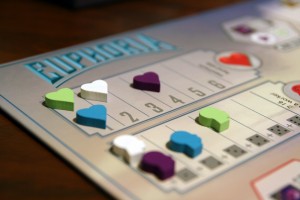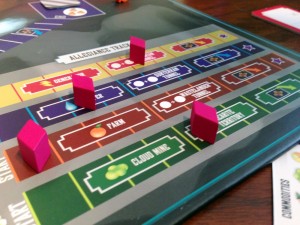 The world as we know it has ended. Be it bombs, floods, locusts, or Y3k, something has destroyed civilization and the survivors have risen from the ashes into a new dystopian society. You and your fellow players are middle level managers in this new world order. Not the most exciting of roles, so you decide it’s time to seize power for yourself. That’s the premise behind the new worker placement game, Euphoria, from Stonemaier Games. Does this new eurogame hold up to the high standards they set with their previous title Viticulture? Read on to find out!
The world as we know it has ended. Be it bombs, floods, locusts, or Y3k, something has destroyed civilization and the survivors have risen from the ashes into a new dystopian society. You and your fellow players are middle level managers in this new world order. Not the most exciting of roles, so you decide it’s time to seize power for yourself. That’s the premise behind the new worker placement game, Euphoria, from Stonemaier Games. Does this new eurogame hold up to the high standards they set with their previous title Viticulture? Read on to find out!
Euphoria is a worker placement game for 2-6 players that plays in about an hour. Euphoria plays best with 4-5 players.
Game Overview:

In Euphoria, players’ ultimate goal will be to spread out their influence and authority among the 4 factions in this new society. Each player will have 2 agents that swear allegiance to one of these 4 factions. However, the agents aren’t the ones doing your bidding. That’s the workers’ job. In Euphoria, workers are represented by 6 sided dice, these minions will go out and gather, harvest, and build to increase a player’s influence among the four factions. But be careful, if your workers become too smart and aware of their horrible lives, they will leave you. This will force another trip to the worker activation tanks to gather more minions. But if a player can keep their workers both happy and dumb, they will be able to spread enough of their authority to seize control of Euphoria and win the game.
Components:
In their previous offering, Viticulture, Stonemaier Games said “death to the wooden cube” with their great custom tokens. Well not to be outdone in their own product line, Stonemaier has kicked it up a notch again with Euphoria. The components that come with this game feel like a love letter to the eurogame. I was able to get my grubby mitts on a Kickstarter version of Euphoria and let me tell you, the realistic looking resources are just awesome. My favorite is the shiny, metal gold bar, but all the resource tokens are a lot of fun to use during the game. As a self-confessed component snob, I love the attention paid to the bits and pieces of Euphoria. For people who missed the Kickstarter, the retail version also includes some unique resources, if somewhat less sexy. However, Stonemaier Games has recently decided to make a new batch of realistic resources available this spring, so rejoice, not all is lost.

Moving on, the game also comes with 6 sets of player tokens, including custom 6-sided dice. I love the design on these and they fit with the theme of the game really well. Also included are 2 decks of cards: recruit and artifact cards. Both are high quality and should hold up to repeated places. I should also point out that Stoinemaier Games seems to have learned a lesson from their first game because the rulebook for Euphoria is very well done. The layout and organization are easy to understand and I have no complaints with it. I found learning the game from the rule book to be a quick and easy process.
My one complaint with the components is the game board. There is a lot going on here and I’ve found the board to be very confusing for new players. Many new players have a hard time wrapping their heads around the different areas, how they interact with each other, and how there are actually 4 factions on the board. Usually it appears as a jumbled mess to them. I’d say it takes about 1/4 to 1/2 a game for players to really wrap their head around what’s going on with the game board. I think some better organization and layout could have really helped here. But other than that one gripe, the components in Euphoria are nothing short of stellar.
How to Play:
Once the game board is setup and each player has their colored pieces, then everyone is dealt 4 recruit cards. Each player selects two of these and then choose one of them to be active at the start of the game. The second card is then placed face down in front of the player. Each recruit will belong to one of the 4 factions and have a unique ability.
There are no rounds to speak of in Euphoria, once the game starts, players just take turns. Beginning with the start player, and going clockwise around the table, each player has two options on their turn:
1. Place a worker
2. Retrieve any/all workers.

To place a worker, a player places one of their 6-sided dice (workers) onto any available space on the board. There are 3 types of spaces:
Multi-Use: These spaces can hold any amount of workers. They are usually places such as the commodity areas where players visit to collect commodities (water, food, bliss or energy) and increase allegiance tracks.
Temporary Use: These can only hold one worker. They have a variety of uses from collecting resources, to digging tunnels, to using markets. If a player wants to use an occupied temporary use space, they can bump the die that currently occupies it out (sending it back to its owner). This creates some nice player interaction and you can even bump your own dice!
One-Time Use: These spaces belong to the construction markets. Each one can hold a single die and requires a resource to be payed first. These workers stay on their space until recalled (usually a bad idea) or until the market is constructed.
To retrieve workers, a player simply collects their dice from the board and returns them to their supply. The player also has the choice of feeding/drugging their worker or letting them starve. If they choose to feed them, they gain 3 morale (morale = hand limit of artifact cards). If they don’t, they lose 1 morale.
Once they’ve collected their worker dice, they must roll them. A player adds up the total rolled on the dice and adds that to their current space on the knowledge track. If their total knowledge is ever greater than or equal to 16, they lose a worker. The player will have to recruit a new workers from the worker activation area for either 3 water or 3 energy. A player can have a max of 4 workers.
In addition to placing workers, players will eventually be using spaces that provide allegiance to 1 of the 4 factions. Each of the factions have an allegiance track to measure their progress. As the counter moves up on the track, players with a face up recruit of a specific faction will gain benefits when they place their workers in that faction area. This can be in the form of extra commodities in the markets, to gaining both resources, and artifact cards in the tunnels. The final space of each of the allegiance tracks allows a player to place an authority star on their recruit.
Speaking of placing stars, that’s how you win the game. Each faction area has an artifact market. A player can go there and trade in 3 artifact cards to place a star in that faction’s area. There are actually 4 ways to place stars in Euphoria: Artifact markets, the allegiance tracks, building markets, and using your one-time-use ethical dilemma card (unfortunately not as cool as it sounds).
The first player to place all 10 stars wins the game.

Game Experience:
Euphoria clocks in as a medium weight euro game. While it has the potential to feel overwhelming to a new player, most seem to quickly realize things that need to be done. I’d say the hardest part for a new player is to figure out where to start. The game board offers a lot of options. But once you get a feel for the game, it provides a good amount of enjoyment. One of my favorite parts about Euphoria is the many paths to victory. I’ve played a number of games, at many different player counts, and each game has played out very differently. Just when I think I’ve found an unbeatable strategy, it has been completely derailed in the next game because of the way the game unfolds.

And that’s one of the interesting things about the game. It seems that everyone has their own ideas about how to win and they just go for it. I’ve found one person that likes to hit the Icaritan artifact markets over and over while another loves to construct markets. As a player, you almost have to be flexible with your strategy as the game unfolds. If people are rushing to build the markets, you had better make sure you get in on that (players without authority stars on the markets once built are penalized).
Which leads me to another interesting design choice in Euphoria. Unlike many worker placement games out there, there is not “placement denial” actions. In most games, you can choose a space to place your worker on so you can block an opponent from going there. In Euphoria, just about every space is free game, be it the unlimited commodity markets or the “bumpable” temporary use spaces. But this actually leads to even more player interaction. In the commodity areas, the total of all the numbers on the dice in the location will change what a player gets when they place a worker. In the temporary spaces, you can bump another player which will give them their die back without them having to use an action to collect it. This can lead to some hard decisions in the game.
I was surprised at how much I enjoyed using the dice as workers. The idea that you have to keep your workers dumb so they don’t leave you was a really unique design choice. When players collect workers, most will nervously eye the knowledge track and run some quick calculations in their head. More than once I’ve seen players leave a worker on the board to not risk losing them with a high roll. Plus, players have to decide where to spend their high value dice vs low ones and this can lead to some interesting options during the game.

And speaking of numbers, worker dice rolls can sometimes make or break you. I actually enjoy a bit of luck in my games (otherwise I’d just go play chess), so it’s interesting how luck can play into the dice in Euphoria. In addition to the above mentioned knowledge rolls, if a player rolls doubles, they get to place both workers on their next turn. This has the potential to be really powerful in the game. Some have complained that it’s actually overpowered but I don’t quite agree. I’ve rarely seen it break the game or give another player an unfair advantage. Only in the most rare cases can a lucky player take charge of the game.
Where the doubles roll does feel powerful is in a two player game. With only two players, it only takes two workers to build a market. Many times I found myself waiting until I rolled doubles, so I could build a market by myself in one turn. My opponent was then penalized for not helping build the market and had to rush to get a star on it. Why the “doubles rule” can be a bit swingy, I honestly have no problems with it and find it adds a bit of excitement to every roll. But for those that hate swings of luck in a game, be forewarned.
I’d say my biggest complaint about the game is the special powers of the recruit cards. Each recruit comes with their own, unique special ability. The game has 48 different recruit cards, each with their own power, and let me tell you, they do not feel balanced at all. Some powers are clearly better than (and are much more used) others. For example: The oracle agent lets you gain 2 knowledge to draw 2 artifacts cards and keep one when you would normally draw one. Gaining knowledge in Euphoria is a really bad thing, so this power is rarely used. Compare that to the Hydroelectric agent who lets you gain an energy when you gain a water (if you have no artifact cards). I’d be using that ability all the time, especially early in the game.

I could be wrong, and perhaps they each are balanced but I’m just not seeing it, because they certainly don’t feel like it. When an opponent is gaining free resources each round at the start of the game and you are waiting for a very specific occurrence to use your power, it feels like you are playing from behind. Or when someone can place 2 stars with one action, that can be extremely powerful. Personally, I wish they would have cut out half the recruits and just made them more balanced. The rulebook does contain a section in the back for advanced rules, one of which is the recruit draft. I would highly suggest using that rule after your first play of the game as it gives players a fighting chance to not be stuck with 2 bum recruits.
But that’s really my biggest complaint about Euphoria. The play time will probably run a little longer your first play through, but I’ve found the 60 minute play time to be optimistic, but still somewhat accurate depending on the player count. We did a 6 player game in 1hr, 15mins, and our 2 player games easily finish under 60 minutes.
Finally, one of the interesting parts of the game is the allegiance track. Each player starts with a face up, active recruit. So you know right away which track everyone will be trying to boost. But the neat thing is that each player has a 2nd, hidden recruit. When the allegiance track marker moves to the 3rd section of that track, any player with a facedown recruit of that faction gets to flip it over and active it. This can play out really interestingly in the game. If a player was rushing their allegiance track to get to the star bonus, they could unwittingly be helping their opponent who can then cash in on all the bonuses without doing any of the work. It’s a devilish little twist in the game that I love.
Final Thoughts:

I think it’s easy to say that Stonemaier Games has another hit on their hands with Euphoria. I love the dice rolling, the different types of worker spaces and the amazing components. While Euphoria plays better at the 4-5 player count, I’ve had a lot of fun with just 2 players. Euphoria scales really well, but you do get a different game between the low player counts and the high. All are fun though.
If you are looking for a medium-weight euro game with some unique mechanics, then Euphoria is absolutely worth a look. The game seems to play out differently each time it hits the table and I enjoy seeing how each new player tackles the game. I love trying out new strategies each game and seem to learn a new trick each time. Euphoria has already hit my gaming table more times than I can count and I’m guessing it will for years to come. Grab a copy today and remember, keep those workers happy and dumb.
If you are interested in getting a copy for yourself, it’s about $50
Final Score: 4 Stars – A great worker placement game with some unique mechanics. Euphoria can be prone to swings of luck, but is still a lot of fun to play.
 Hits:
Hits:
• Amazing components
• Many paths to victory
• Like using dice as workers
• Unique game mechanics, especially for a worker placement game
Misses:
• Game board can be confusing to new players
• Recruit cards do not feel balanced























From someone who has owns, loves, and has played Euphoria a number of times, I find this review to be very spot on. I cannot disagree with anything you have said here. I love the game. I also think your critiques are spot on too. Some of the recruits seem a bit worthless and you can get stuck with 2 bum recruits while someone else gets 2 really good ones. But, I have not played with the recruit draft yet which sounds like a great idea for our next play. I really like that you can never use the same strategy to win this game. Your recruits and the strategies of other players, a long with the chance of dice rolls, make following the same strategy every time you play tough. But, if other players hit the markets hard, you had better be involved. I love the fact that workers cannot block spaces. I greatly, stress greatly, dislike that aspect of the Manhattan Project. All in all, this is one of my favorite games. For me, this is just about a perfect 10 for a worker placement and Eurogame. I highly recommend this game and your review of it as being very accurate!